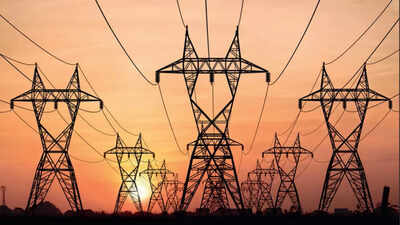- News
- City News
- noida News
- Long outages hit Noida as power demand soars
Long outages hit Noida as power demand soars

Representative image
NOIDA: Power demand in the city this summer is at a record high and the distribution network is feeling the heat.
On Wednesday, a transformer that broke down due to an overload shut off electricity for nearly 14 hours in Sector 30, which is home to around 5,000 residents. Inverters too had given out by the time power was restored around 4.30pm, leaving residents stewing without fans. Outside, the maximum temperature touched 42 degrees Celsius.

Noida's current peak demand of 1,800-1,900 MW is significantly higher than the pre-lockdown levels of 2019, putting pressure on its distribution network, which remains prone to snags. Power demand in Greater Noida has also risen sharply with more people moving in.
Pramod Verma, who heads the RWA, said the affected transformer was in D block. It conked out around 2.30am. Verma said the incident served yet another stark reminder about the need to upgrade Noida's power transmission infrastructure. "Our sector is nearly 30 years old. From 100 houses about 30 years back, there are 600 houses today, most of which have two to three floors. Since this is a prime location, the population has grown exponentially. Consequently, there is heavy use of ACs, fans and coolers. But the infrastructure is outdated. The result is frequent long outages due to local faults and equipment burning down, like the transformer," said Verma.
A local resident alleged that calls were made to the power department after the transformer snag, but the phone lines went unanswered. "We thought it would be a local fault, which would get repaired in some time. But power supply wasn't restored till early evening," said the resident.
In Arun Vihar (sectors 28, 29 and 37), another of the city's prime neighbourhoods, residents reported frequent outages and voltage fluctuations after sparks on an electrical pole in front of Park View "that looked like Diwali firecrackers". "There were cars parked under the pole, but the sparks fortunately didn't damage them. We feared a major accident," said its chairman IP Singh.
Here, too, outdated power infrastructure has led to recurrent snags and outages. "Junction and feeder boxes and loose wires on poles need to be fixed. Power cables and internet as well as cable TV lines need to be separated and meter boxes need to be installed to keep a check on unauthorised use of power in common areas," said Singh.
At Sector 19, residents said of late, power cuts had been happening daily for an hour or two. The RWA claimed it receives no prior intimation from the power department about the outages. "Power supply is being cut daily for a period of 1-2 hours rotationally in each block. Sometimes, even at night when people are asleep. Residents are annoyed and plan to take out a protest rally," said RWA chief Laxmi Narain.
In Greater Noida, where private company NPCL handles power supply, residents in the newly populated sectors of Greater Noida West said the average duration of outages daily was 3-4 hours.
VN Singh, chief zonal engineer of the Noida power department, said electricity demand had risen to its highest so far. "This is because while commercial and industrial activities have increased after Unlock, more people are also now living in the city as compared to the last few years. Power demand ranged from 1,000-1,400 MW till 2019. Then it saw a dip to 800-900 MW between 2020 and 2021 due to the Covid lockdown. But this year, as full unlock has been implemented, the summer has seen a new high of 1,800-1,900 MW demand. This is likely to increase further," said Singh, adding there is no power shortfall.
Sarnath Ganguly, vice-president (operations), NPCL, echoed him. "There has been an unprecedented rise in demand for power in the Greater Noida area this summer season as the peak load has already crossed 550 MW as against earlier of 300-380MW. Present load requirement of Greater Noida (West) is around 130-135 MW, which is increasing day by day," he said.
He said all 33 kV feeders are loaded beyond capacity to meet the peak load of 130-135 MW in Greater Noida West alone. "This results in tripping/fault in the main 33 kV lines, which in turn affects supply to housing societies of Greater Noida West. Even in case of a breakdown of any of the 33kV feeders, there is no scope to transfer the load to other 33 kV feeders, which are already overloaded," said Ganguly, adding builders in several societies in Greater Noida West have not set up an internal distribution network of the required capacity, resulting in regular breakdowns.
It's not that NPCL hadn't anticipated this increase in power demand. It laid a 22km line to bring an additional 100 MW of power from the new 400 kV substation in Sector 123 in Noida. "However, due to considerable delay in energisation of the Sector 123 substation, NPCL could not get this additional power for the Greater Noida West area," said Ganguly, adding the current outages would end once the new substation is activated.
On Wednesday, a transformer that broke down due to an overload shut off electricity for nearly 14 hours in Sector 30, which is home to around 5,000 residents. Inverters too had given out by the time power was restored around 4.30pm, leaving residents stewing without fans. Outside, the maximum temperature touched 42 degrees Celsius.

Noida's current peak demand of 1,800-1,900 MW is significantly higher than the pre-lockdown levels of 2019, putting pressure on its distribution network, which remains prone to snags. Power demand in Greater Noida has also risen sharply with more people moving in.
Pramod Verma, who heads the RWA, said the affected transformer was in D block. It conked out around 2.30am. Verma said the incident served yet another stark reminder about the need to upgrade Noida's power transmission infrastructure. "Our sector is nearly 30 years old. From 100 houses about 30 years back, there are 600 houses today, most of which have two to three floors. Since this is a prime location, the population has grown exponentially. Consequently, there is heavy use of ACs, fans and coolers. But the infrastructure is outdated. The result is frequent long outages due to local faults and equipment burning down, like the transformer," said Verma.
A local resident alleged that calls were made to the power department after the transformer snag, but the phone lines went unanswered. "We thought it would be a local fault, which would get repaired in some time. But power supply wasn't restored till early evening," said the resident.
In Arun Vihar (sectors 28, 29 and 37), another of the city's prime neighbourhoods, residents reported frequent outages and voltage fluctuations after sparks on an electrical pole in front of Park View "that looked like Diwali firecrackers". "There were cars parked under the pole, but the sparks fortunately didn't damage them. We feared a major accident," said its chairman IP Singh.
Here, too, outdated power infrastructure has led to recurrent snags and outages. "Junction and feeder boxes and loose wires on poles need to be fixed. Power cables and internet as well as cable TV lines need to be separated and meter boxes need to be installed to keep a check on unauthorised use of power in common areas," said Singh.
At Sector 19, residents said of late, power cuts had been happening daily for an hour or two. The RWA claimed it receives no prior intimation from the power department about the outages. "Power supply is being cut daily for a period of 1-2 hours rotationally in each block. Sometimes, even at night when people are asleep. Residents are annoyed and plan to take out a protest rally," said RWA chief Laxmi Narain.
In Greater Noida, where private company NPCL handles power supply, residents in the newly populated sectors of Greater Noida West said the average duration of outages daily was 3-4 hours.
VN Singh, chief zonal engineer of the Noida power department, said electricity demand had risen to its highest so far. "This is because while commercial and industrial activities have increased after Unlock, more people are also now living in the city as compared to the last few years. Power demand ranged from 1,000-1,400 MW till 2019. Then it saw a dip to 800-900 MW between 2020 and 2021 due to the Covid lockdown. But this year, as full unlock has been implemented, the summer has seen a new high of 1,800-1,900 MW demand. This is likely to increase further," said Singh, adding there is no power shortfall.
Sarnath Ganguly, vice-president (operations), NPCL, echoed him. "There has been an unprecedented rise in demand for power in the Greater Noida area this summer season as the peak load has already crossed 550 MW as against earlier of 300-380MW. Present load requirement of Greater Noida (West) is around 130-135 MW, which is increasing day by day," he said.
He said all 33 kV feeders are loaded beyond capacity to meet the peak load of 130-135 MW in Greater Noida West alone. "This results in tripping/fault in the main 33 kV lines, which in turn affects supply to housing societies of Greater Noida West. Even in case of a breakdown of any of the 33kV feeders, there is no scope to transfer the load to other 33 kV feeders, which are already overloaded," said Ganguly, adding builders in several societies in Greater Noida West have not set up an internal distribution network of the required capacity, resulting in regular breakdowns.
It's not that NPCL hadn't anticipated this increase in power demand. It laid a 22km line to bring an additional 100 MW of power from the new 400 kV substation in Sector 123 in Noida. "However, due to considerable delay in energisation of the Sector 123 substation, NPCL could not get this additional power for the Greater Noida West area," said Ganguly, adding the current outages would end once the new substation is activated.
FOLLOW US ON SOCIAL MEDIA
FacebookTwitterInstagramKOO APPYOUTUBE
Looking for Something?

Start a Conversation
end of article
Visual Stories
Quick Links
UP NewsDelhi TemperatureChennai WeatherBangalore TemperatureUP Board Result 2022Coronavirus in DelhiRTPCR test in GurgaonHyderabad RainPollution level in BangaloreDelhi SmogDelhi TemperatureNoida AQIGurgaon AQI todayFire in MumbaiMumbai RainsCovid 19 RT PCR Test in NoidaDelhi AQI todaySrinagar encounter










